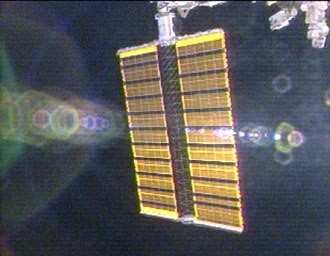Manufacturer Lockheed Martin Takes A Bow
 The fourth and final pair of massive
solar arrays, built by Lockheed Martin at its Space Systems
facility in Sunnyvale, have been installed on the International
Space Station by the crew of the space shuttle Discovery. The two
new arrays have been deployed and are generating electricity.
The fourth and final pair of massive
solar arrays, built by Lockheed Martin at its Space Systems
facility in Sunnyvale, have been installed on the International
Space Station by the crew of the space shuttle Discovery. The two
new arrays have been deployed and are generating electricity.
"It is a testament to the professionalism of the STS-119 crew
and the mission support team that they made this challenging ISS
construction project look easy, and the deployment of the new
arrays was a sight to behold," said Brad Haddock, Lockheed Martin
ISS program director. "To see all eight of our arrays deployed is
wonderfully satisfying, and we're confident that this addition will
provide the electricity to fully power science experiments and
support expanded crews for many years to come."
The Space Systems ISS solar arrays are the largest deployable
space structure ever built, and are by far the most powerful
electricity-producing arrays ever put into orbit. When the station
is completed the eight flexible, deployable solar array wings will
generate continuous power required for the on-orbit operation of
the ISS systems.
The eight array wings were designed and built under a
$450-million contract from The Boeing Company, the prime contractor
to NASA responsible for design, development, construction and
integration of the ISS.
Each of the eight wings consists of a mast assembly and two
solar array blankets. The blankets each have 84 panels, of which 82
are populated with solar cells. Each panel contains 200 solar
cells. The eight photovoltaic arrays thus accommodate a total of
262,400 solar cells. Fully deployed in space, the active area of
the eight wings -- each 107 by 38-feet -- encompass an area of
32,528-square feet and are designed to provide power to the ISS for
15 years.
In addition to the arrays, Space Systems in Sunnyvale designed
and built other elements for the Space Station. Two Solar Alpha
Rotary Joints (SARJ) - each 10.5 feet in diameter and 40 inches
long - were delivered to ISS in 2006 and 2007, to maintain the
arrays in an optimal orientation to the sun while the station
orbits the Earth once every 90 minutes. A pair of Thermal Radiator
Rotary Joints (TRRJ) - each five and a half feet long and three
feet in diameter - was launched in 2002, and maintains Space
Station thermal radiators in an edge-on orientation to the sun that
maximizes the dissipation of heat from the radiators into
space.

Space Systems also produced the Trace Contaminant Control System
-- launched to ISS as an element of the US Destiny Laboratory
module in 2001 -- an advanced air processing and filtering system
that ensures that over 200 various trace chemical contaminants,
generated from material off-gassing and metabolic functions in the
Space Station atmosphere, remain within allowable concentration
levels. It is an integral part of the Space Station's Cabin Air
Revitalization Subsystem.
 ANN's Daily Aero-Linx (05.02.24)
ANN's Daily Aero-Linx (05.02.24) ANN's Daily Aero-Term (05.02.24): Touchdown Zone Lighting
ANN's Daily Aero-Term (05.02.24): Touchdown Zone Lighting Aero-News: Quote of the Day (05.02.24)
Aero-News: Quote of the Day (05.02.24) ANN FAQ: Contributing To Aero-TV
ANN FAQ: Contributing To Aero-TV NTSB Final Report: Cirrus Design Corp SR20
NTSB Final Report: Cirrus Design Corp SR20




